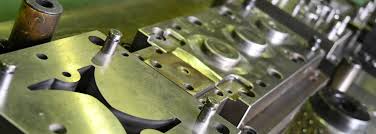Overview:
Metal stamping is a precision manufacturing process that involves transforming flat metal sheets into desired shapes and forms using stamping presses and tooling. This versatile technique creates intricate parts and components with high precision, efficiency, and repeatability, catering to diverse industries and applications.
Metal Stamping Process:
Tool and Die Preparation:
- Die Design and Development: Utilization of CAD/CAM software to design tooling dies and molds for specific part geometries.
- Die Fabrication: Fabrication of dies involves machining, EDM (Electrical Discharge Machining), and heat treatment for durability.
Material Feeding and Stamping:
- Material Preparation: Metal sheets are prepared and fed into stamping presses, ensuring precise dimensions and material quality.
- Stamping Operation: Presses apply force to form, cut, or bend metal sheets using specialized dies and tooling.
Secondary Operations and Finishing:
- Secondary Processes: Additional operations like deburring, threading, or welding to refine and prepare stamped parts for use.
- Surface Treatment: Applying surface finishes like plating, painting, or coating to enhance aesthetics and properties.
Types and Applications:
Types of Metal Stamping:
- Progressive Stamping: Sequential operations performed in a single press, ideal for high-volume production of intricate parts.
- Deep Draw Stamping: Creates parts with significant depth, such as cups or cylinders, by drawing the material into a die cavity.
Diverse Applications:
- Automotive Industry: Utilized for manufacturing automotive components like brackets, chassis parts, and engine components.
- Electronics and Appliances: Produces parts for consumer electronics, enclosures, connectors, and housings.
- Aerospace and Industrial Engineering: Used in aerospace for structural components and in industrial engineering for machinery parts.
Precision and Quality Assurance:
Tolerances and Precision:
- Tight Tolerances: Achieves high precision and tight tolerances, typically within a few micrometers (μm) or less.
- Tool Maintenance: Regular maintenance of dies and tooling ensures consistency and part accuracy.
Quality Control Measures:
- In-Line Inspections: Implementing in-line inspections using automated systems to ensure part conformity during production.
- First Article Inspection (FAI): Comprehensive inspection of initial parts to verify conformance to specifications.
Metal Stamping stands as a cornerstone in manufacturing, providing precise and cost-effective solutions for producing intricate parts across various industries. Its capability to deliver high-volume production, coupled with stringent quality controls, makes it an integral process in modern manufacturing.

